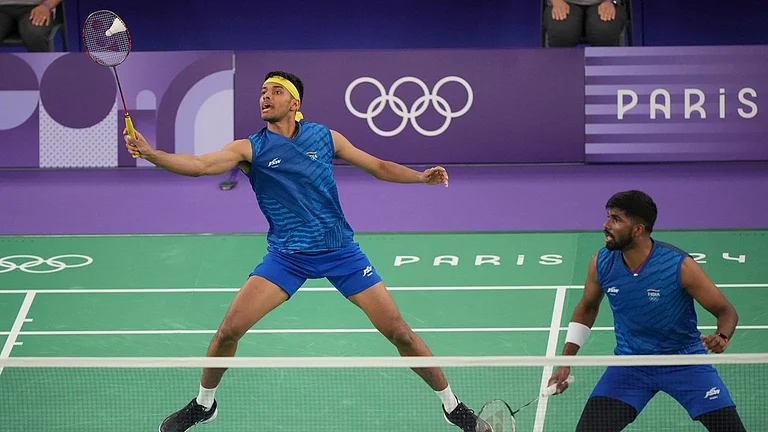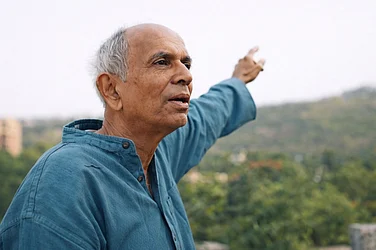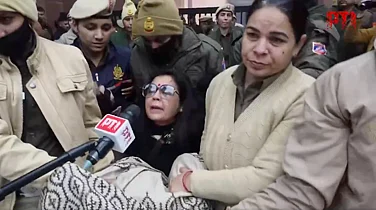Social scientist Ashis Nandy has quite a way with his gnomic observations on Indian politicians. For Arvind Kejriwal, he had specially qualifying words that put a finger right on the AAP’s core dichotomy. The Delhi chief minister is both an insider and outsider in Indian politics, Nandy had said. “The Mufflerman,” he said in an interview after the Aam Aadmi Party (AAP) won a startling 67/70 seats in the 2015 assembly elections, “should remain like Spiderman, an outsider.” But remaining a complete outsider would be “suicidal” too, Nandy said—what Kejriwal had to do is keep one foot inside.
So how much of a pure political animal could Kejriwal, the ‘common man’ who walked right over those yellow barricades to the other side, afford to be? Could his party become just another party, a product vying for space on the supermarket shelves? One among many, like numerous other sectoral interests?

A video grab of Delhi chief secretary Anshu Prakash leaving the residence of CM Arvind Kejriwal
The word ‘AAP’ was to denote a new sort of politics. The moral code that brought it into being was meant to be always front and centre, while it stayed tactically aware and combative. It claimed an essentially Gandhian streak. Have they forfeited it somewhere? Partymen say they have honoured their promise to the people—and the vox populi favours them. But immersing themselves in the minutiae of mohalla politics, tiring themselves out in unceasing skirmishes, have they lost something of the big picture?
The word ‘Gandhian’ didn’t exactly trip off the tongue last week, when AAP leaders allegedly roughed up Delhi chief secretary Anshu Prakash. But the incident fit into a general picture forming now about AAP: as characterised by a certain breed of confrontational activist, capable of riding roughshod over niceties if push comes to shove, being ‘oppositional’ even in power. Social activist Medha Patkar, a fellow traveller for some of AAP’s initial miles, had this cautionary note to offer: “The party should be careful. There is space for alternatives in Indian politics, and need for change…and so many issues concerning the people, concerning the poor and farmers. AAP should be careful not to digress into other areas, not to get distracted.” While acknowledging that the behaviour of bureaucrats and the L-G “has not always been fair”, she emphasised: “We are obviously completely against any violence.”
It’s a low-grade bush fire that AAP has been fighting—the Centre yesterday, the bureaucracy tomorrow, the L-G another day. Hence, a sense of being permanently off-kilter. Now there’s talk of a constitutional crisis—though most experts, as senior advocate Sanjay Hegde confirmed to Outlook, don’t see a case there. There’s even talk of Kejriwal being booked by police for the Anshu Prakash case (as the chief secretary has alleged conspiracy in his complaint, everyone present at the meeting can be charged with complicity). There’s also cross-talk that AAP, as a last resort, may fall back on a ruse, even engineer a crisis, to gain sympathy. This AAP leaders deny even as they train their guns on the BJP for being the source of most of their woes. “Everything we want to do for Delhi, they block. Hence the multiple flashpoints,” says a senior AAP leader.
Was the AAP government right to see the bureaucracy itself as an antagonist? Yes, the IAS ultimately answers to the central government, so things are indeed loaded, but with the whole force virtually in revolt, a question looms: is AAP overdoing it? Party leaders castigated MLA Naresh Baliyan for saying, days after the Prakash episode, that bureaucrats “could” be beaten if they delay files unduly, and the police booked him for it—making him the 16th AAP man to be booked by the Delhi police since 2015. AAP has always fostered a perception that all others are corrupt, inefficient and collude with each other.
But crossing this new threshold, is it good politics for Kejriwal? Speaking to a cross-section of analysts, and travelling across many Delhi localities listening to people’s responses, it becomes evident he is very much in the game. The voters speak of the demonstrable effects of policy—on water, education, health, power—and the experts, even disenchanted former associates, seem keen to offer a qualified defence, perhaps as a reaction to the much bigger forces that have trapped AAP in a long siege.

Three years after, Nandy reassesses Kejriwal carefully. “He’s more of a politician now—shrewder—in the way he has purged the party of opponents. The earlier stalwarts of AAP are gone now; that shows his political skills. The earlier Kejriwal didn’t have these skills,” Nandy concedes, speaking to Outlook. But he adds: “On the whole, Kejriwal’s appeal is intact. This is because, leave all things aside, he’s still not seen as a typical politician.” Nandy traces this through the present impasse, citing how “other parties are uncomfortable with AAP”. And why they behave, despite Delhi being a small state, “as if he’s a major threat, using the bureaucracy and all central powers against him”. For Nandy, the reason goes back to his original formulation. “Because they see him as a usurper. He’s still an outsider holding out the same promise, of remaining one. Otherwise, I don’t see a politically valid reason for so much desperation among its rivals.”
Elements of realpolitik have not been as absent as one may have expected—suggesting more ways than one in which Kejriwal may have become “more of a politician now”. At one level, Kejriwal all but stopped his constant criticism of Prime Minister Narendra Modi after MLAs attributed to this their local-body poll debacle. At another, the Punjab fiasco and its Canadian backstory played out recently, with even former AAP candidate Gul Panag tweeting about the party’s “poorly calculated flirtation…(with) the K gang”. In the same vein, Delhi-based historian Syed Irfan Habib, by no means a detractor, says: “AAP has a silent approach on some things—like the ongoing communal tensions in Trilokpuri. Why should they give a free hand to communal elements of both sides—they should speak against it.”
Inept attempts, perhaps, that only confirm their amateur status and only a side story. The main script, as Nandy also hints at, is the unceasing artillery fire AAP has been facing from the ruling BJP at the Centre. This is the context in which it expects—and probably receives—sympathy. “I’m sure there have been efforts to break or split the party by its rivals,” Nandy says. AAP spokesperson Adarsh Shastri confirms this sense of being unfairly targeted: “The poor feel AAP is not being allowed to function. They feel it’s being victimised even in the office of profit issue. Delhi’s educated classes know we are not the problem-creators but they say, ‘why doesn’t AAP just sort it out with the government’.” The big change, he says, is that Modi was once seen as an achiever and AAP as a fighter. “Now all, rich or poor, think Modi is doing nothing, while we are delivering.” There are reports that the BJP is aware of AAP’s continued popularity as well, and so is unwilling to escalate the crisis.
A former colleague of Kejriwal, who is no longer with the party, rues that AAP risked all with brinkmanship. “Where they went wrong is in fiddling unduly with the grammar of governance. Perhaps success came too early to AAP.” Later, as it inevitably faced a series of reversals—be it the administrative blockades on everything from ration and salaries to teacher appointments and land for mohalla clinics or the disqualification of 20 MLAs—AAP’s urgency to respond to each event in public protest mode wore out many listeners, the former colleague says. “Still, there are many ways to protest and deal with bureaucracy, even uncooperative ones sent by the L-G to put roadblocks,” he says. While the Centre’s attitude “might even generate sympathy for AAP”, the question is what signal violence sends about the party. Since that episode, there is a sense that some threshold of decency has been crossed.
To be fair, a lot of the AAP government’s bellicosity comes from frustration: its room for policymaking has shrunk. The L-G stands accepted by the Delhi High Court as head of administrative power in Delhi, and the Supreme Court has reserved judgement on AAP’s appeal since December. So public order, land, police and services, including the power to pick bureaucrats, are in the L-G’s hands. “The situation is,” says an AAP leader, part of its political affairs committee, “frustrating for our rank and file.”
One instance highlights how bad the disconnect is. Delhi’s power secretary Varsha Joshi put out a tweet on February 25, claiming credit on the bureaucracy’s behalf for reforms that ensured Delhi’s power scenario “improved sharply” in the last year or two: “…the decision to privatise Delhi Discoms was taken by ‘babus’ and sustained by extreme efforts back then.” So, apparently without exception, AAP’s tenure is acknowledged to have delivered some results—water woes have ebbed, local schools have improved perhaps for the first time in remembered history, and mohalla clinics are widely regarded as a good model, even versus Modicare. But bureaucrat-AAP relations are so sour, nobody gives credit where it is due.
Even so, there are those willing to offer implicit, back-handed support. “I welcome the IAS association for highlighting one incident,” says Ashok Khemka, the IAS officer who earned a name for fighting corruption in Haryana. “I only wish the IAS speaks out on other equally pressing social issues. The IAS is not a closed society that will speak only for its own members—we must not subvert the conscience of young recruits who are, from day one, getting only this message.”

AAP is naturally anathema to the parties it replaced in Delhi, a city with tremendous symbolic value in Indian politics. But there are other sectors of hostility. Just like the bureaucracy, the media has had a conflicted history with AAP, yo-yoing from over-the-top evangelism to outright blackouts. If it’s losing the battle of perceptions, is some of it self-inflicted? Recall how partymen barred the media from the secretariat in their early days, muffling many sympathetic voices, and AAP’s own role in creating a sense of fatigue among Delhiites becomes clear. But, Paramjit Singh Judge, who teaches sociology at Guru Nanak Dev University, tells Outlook: “Kejriwal knows how bureaucracy works, being from the services himself. The basic problem in Delhi is not that—it’s that the Indian State does not want Kejriwal to stay, nor does your community (the media).” Kejriwal, now trying to create conditions for a rapprochement with the bureaucracy, could sorely do with a second honeymoon period.
But AAP leaders say they are on top of the situation, that their strongest supporters in Delhi slums, among the city’s poorest, understand the party. They feel their opponents are mostly status quoists resistant to change: “Five hundred times we have been written off by analysts but our supporters don’t feel that way. We always seem to come out stronger,” says AAP spokesperson Raghav Chadha. “We have walked the talk on development. We are in fact expanding, going into Haryana, consolidating in Punjab, preparing for Lok Sabha. It’s Modi’s anti-corruption agenda that has gone bust, especially after the Nirav Modi case. Even on anti-corruption we have done much better than most parties,” says Chadha.
“Much better than most” is a considerable scaling down of ambition for a party whose central premise was the fight against corruption. AAP has veered away from it to other humdrum, but very material concerns: cheaper power and water, better public health, education and ‘doorstep delivery’ of services. These arguably lack the visceral (and moral) appeal of the fight against corruption, but Kejriwal perhaps senses individual voters like to see solid benefits flowing their way. It may denote a pettification of sorts, to becoming a typical city party—a provider of services rather than an usherer of ethical transformation—even if there’s nothing to suggest cheaper power does not unite voters across caste and religion as much as moral appeals do!
Kejriwal had promised to end the graft that colours the everyday life of all Indians—the sort that got deterred, initially, by calls to a mobile number plastered across a poster with his face on it. “But on May 23, 2015, the home ministry issued a notification that took away the Delhi government’s powers over the anti-corruption bureau,” says a senior AAP leader.
The scene of that drama was to shift to Punjab, where AAP had expected a win and a chance to demonstrate what governance without (as much) corruption looks like. They are yet to reconcile with the scaling down of their dreams after that loss. Disenchantment can bring about curious behavioural changes, though. AAP 2.0 is doing things it was unlikely to contemplate in its first flush. For example, a former Congress leader probably had slim chances of getting into the Rajya Sabha on an AAP card three years ago. That two of its RS nominees belong to the same varna category is also the kind of optics AAP might have avoided. It was rumoured internal politics stalled the nomination of Ashutosh and Kumar Vishwas. Unknown faces plus money considerations—how long AAP can sustain on crowd-funding is a question—carried the day in the RS. “Politics can be cruel, it’s the same in any party,” says Judge.

Mohalla clinics are one of the things the poorer sections of the Delhi electorate associate with AAP
Maybe such shifts help AAP keep one foot in and one outside the door—maybe it has always been so since early fellow travellers started dropping out. “From 2011 to 2015, a mix of upper and lower middle class people volunteered for us. Higher middle classes identify less and less with AAP now. Many left with the exit of Yogendra Yadav and Prashant Bhushan but our daily operations are still dominated by volunteers,” says one of the 700 or so “hardcore” volunteers still battling on, all from the higher and upper middle class.
Attrition is natural as AAP does not pay its volunteers. “We tried, but due to a hue and cry from the opposition, we could not secure posts in Delhi INStitutions for our volunteers,” says the volunteer. “Setting”, as Kejriwal may have called it in his common Delhi lingo, which can be endearing or infuriating depending on the class of the listener.
In 2015, Delhi cleared a bill for a 400 per cent salary hike to MLAs and Ministers (from Rs 90,000 to Rs 2 lakh per month plus perks). This was one of AAP’s earlier attempts to adjust with reality: political work requires money, even for a party keen to demonstrate that elections can be low-cost endeavours. That bill was twice returned by the Centre, which found the hikes out of sync with Delhi’s revenues. (Meanwhile the Centre has provided for regular salary reviews for MPs in the budget and essentially backed foreign funding for political outfits through a series of retrospective amendments to the FCRA). So even as the attrition continues, an AAP senior sounds confident: “The situation will become clearer as elections approach, nothing galvanises supporters like elections.”
Habib, however, traces some of AAP’s slipshod manner and also its moral diminution to this street-smart work ethic. “The party emerged from a movement, so most people who joined were from a non-political background. A large number of mobilisers got tickets—often people given to loose talk, not real leaders, not suave. They commit blunders, one faux pas after another. Kejriwal himself used to do it.” Because of its mistakes, its real work gets missed, concedes Habib.
For a party born in the crucible of image management, quite an unpredictable line of evolution. Perhaps the next step could be to recover its original gene, to expand not territorially but morally. To be a viable party, perhaps it needs to remain a movement too. Nandy’s inside/outside formula. “Whatever happens,” says Judge, “AAP should work and propagate information on that, aaraam se—quietly. They should not make too much noise.”
By Pragya Singh in New Delhi


























